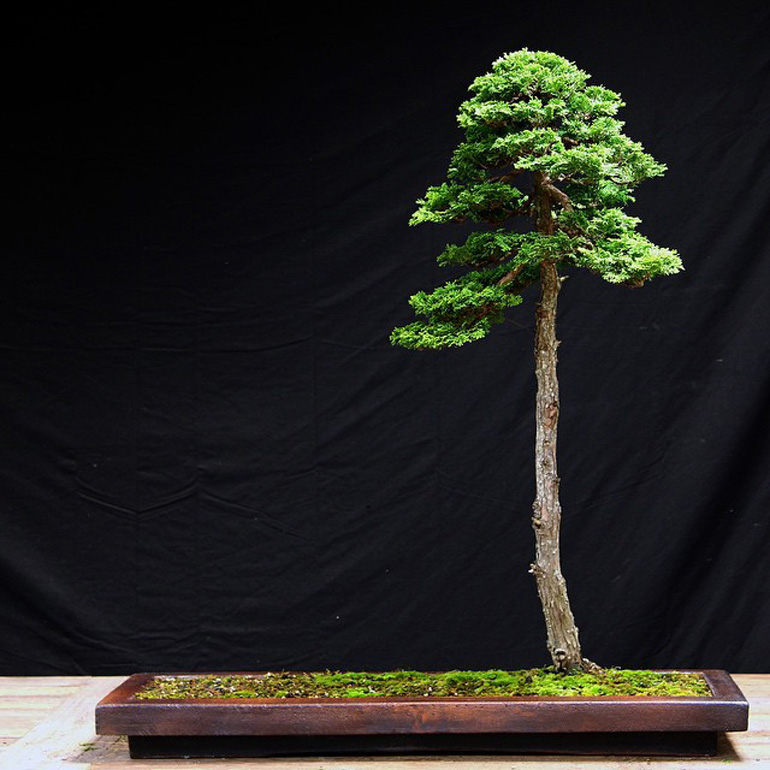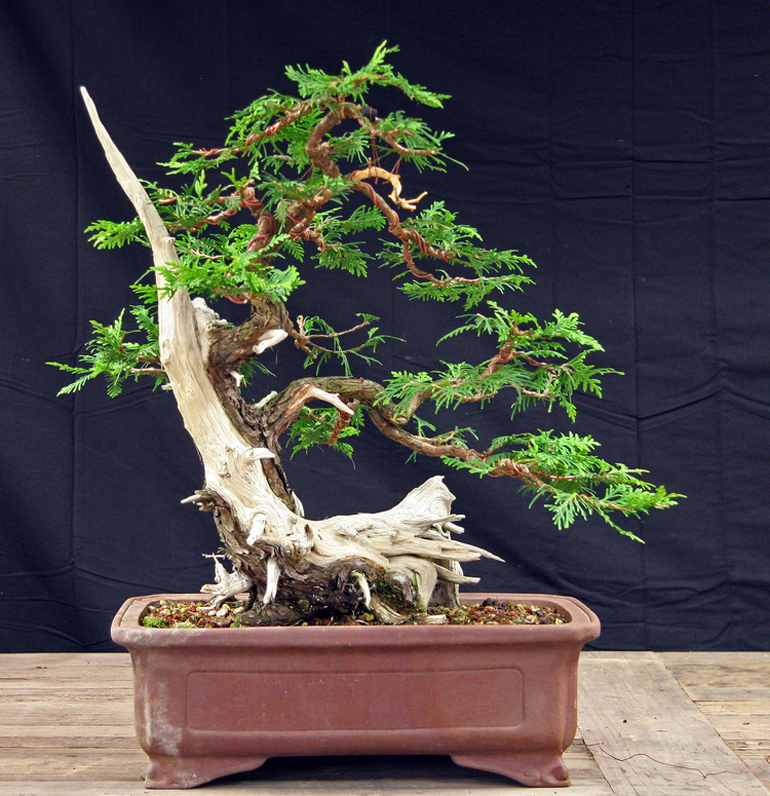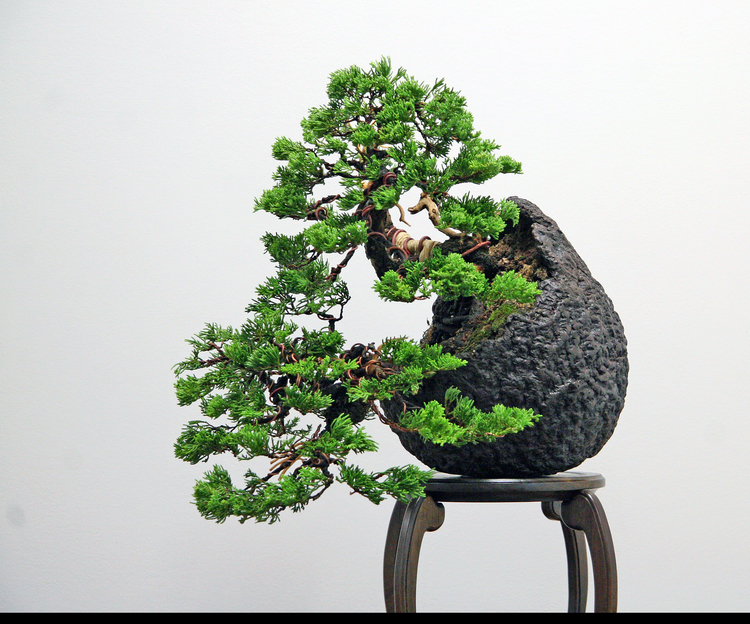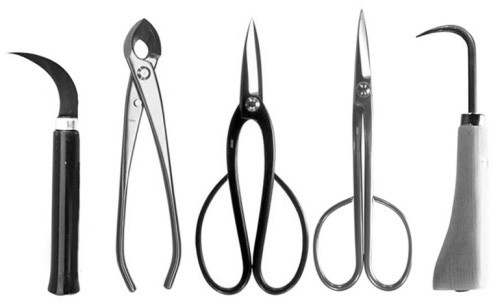
This stately distinctive Hinoki is from Michael Pollock’s blog Bonsai Shinshei as are the other two bonsai shown here. Here’s Michael’s caption: “My lone Hinoli cypress after a quick fall cleanup. Falling deeper in love with this pot that Ron Lang and I collaborated on.”
Got Artisans Cup photos with species and artist labels? I wanted to show Ron Lang’s (and Sharon Edwards-Russell’s) pots that held seven of the remarkable trees at the Artisans Cup. Problem is, my photos are spotty and mostly unlabeled and the same goes for other Cup photos I’ve been able to dig up. So we’ll have to wait.
Meanwhile, I borrowed this post from our archives. The now famous Hinoki bonsai above was displayed at the Artisans Cup, looking pretty much like what you see here (though all the trees were surrounded by darkness and highlighted with spot lights at the Cup). The pot is by Ron Lang.
There was a time not too long ago when most of the bonsai you saw conformed to Japanese standards. True, there has long been a wealth of bonsai in other east Asian countries, but it was mostly Japanese bonsai that first found its way West (this is especially true in North America).
Now, since bonsai has caught fire around the world, there’s a creative revolution taking place. Bonsai artists and enthusiasts are feeding off of each other and experimentation has become the norm. The results are often trees that amaze and inspire. And, as in the case of the Hinoki above (and its pot), trees that are so distinctive that they stick in your mind long after you see them.

A Northern white cedar (a variety local to Canada and parts of the northern U.S. including right here on my land in Vermont). Like the other two trees shown here, it belongs to Michael Pollock who had just wired it when he posted it, so it has a bit of that waiting-for-the-foliage-to-fill-in look. He also mentioned that it needed a new pot. Still, freshly wired and in need of a new pot or not, I don't know many people who wouldn't want this bonsai in their collection.

Unfinished, but still a sweet bonsai. It's a Juniper procumbens from nursery stock. The pot (by Dale Cochoy).
All the bonsai in this post are from Michael Pollock’s Bonsai Shinshei blog.
 25% off Koyo Bonsai Tools
25% off Koyo Bonsai Tools
Including Stainless and other Masters Tools
made in Japan
plus and extra 10% off for orders 100.00 or more
I like Michael Pollack’s hinoki cypress at the Artisans Cup very much. I put this tree as one of my favorites from the show in my new blog: https://bonsaipenjing.wordpress.com/. After seeing so many big collected conifers with carved shari and jins, this display stood out. It evokes a feeling of an expansive American prairie; a skinny lone tree, a large empty space, a journal and a compass, they accentuate an American pioneering spirit. Ron Lang’s wide lip pot also compliment the tree very well.
In music, Aaron Copland created the American sound in his compositions such Rodeo, Appalachian Spring etc. The sound is unmistakably American to listeners. To me those big collected conifers, though very impressive and awe inspiring, are still bound very much by Japanese aesthetics except they are American native trees.
I got photos of six of the eight Lang pots at The Artisan’s Cup.
You can see them at the Facebook page of the Bonsai Society of Greater New Haven.
https://www.facebook.com/BonsaiNewHaven/posts/618757664929172
(and you can repost them here, if you want, if you credit me as ceolaf)
Thank you Hoe Chuah,
I agree with much of what you have to say and I really like your blog and the photos you took. So much so that I’d like to use some here in Bark, fully attributed and linked of course. Id also like to quote your remarks (even though I seem to be asking, I’m really just letting you know… I never wait for permission and as long as we attribute and link, no one ever complains…).
Thanks ceolaf,
I’ll definitely use them. I have a thing for Lang pots and I’m not alone in that regard.
BTW: your previous comment on Visceral Wonder in response to Alex brings up a good point about categories. The 2014 U.S. National Exhibition had 12 judged categories. Twelve worthy and happy winners and a lot less comparing apples and oranges (Picassos and Rembrandts).
Back to judging? I’m glad to talk judging.
Yes, Bill Valavanis’s National Exhibition had quite a few categories, and he added a “Medium Sized” category between Shohin and the large trees that always get so much attention. That’s not only recognizing that some trees simply cannot be compared to others (thus, the 11 previous categories) and the fact that judges (or people) have predictable biases and tendencies that are less than desirable. Clearly, Bill think that these medium trees are worthy of notice, and the judges (or people) simply cannot ignore size when judging a tree.
Of course, he also has sufficient sponsors to pair each of these awards with substantial cash prizes.
This opens up the question — a question without a definitive answer — of how many categories a show should have. Should local club shows even have judging and awards? Should there be a minimum number of entrees in a categories to award a winner?
More importantly, what is the *purpose* of having winners at bonsai shows? Is it good good bonsai? Is it good for your local club? Does it create more good feeling than bad feeling? Does it perpetuate inequality among owners and artists? Does it retard progress and development of the art? Why do we do it?
Does anyone even know the purpose? Or is it just, as Tevye explained, tradition?
Awards create interest. Though not everybody cares, most people like them. Or, at least like to discuss, debate or criticize them.
I agree, awards can create interest.
Is that WHY we do them? If so, are they the best way to create interest? Do we award them in a way that best creates interest?
For example, would voting on the awards create more interest? Would have more (or fewer) awards create more interest? What categories would create the most interest?
And does attaching (sometimes large) cash prizes to the recognition intrinsic to the award create interest? Is that why we do that?